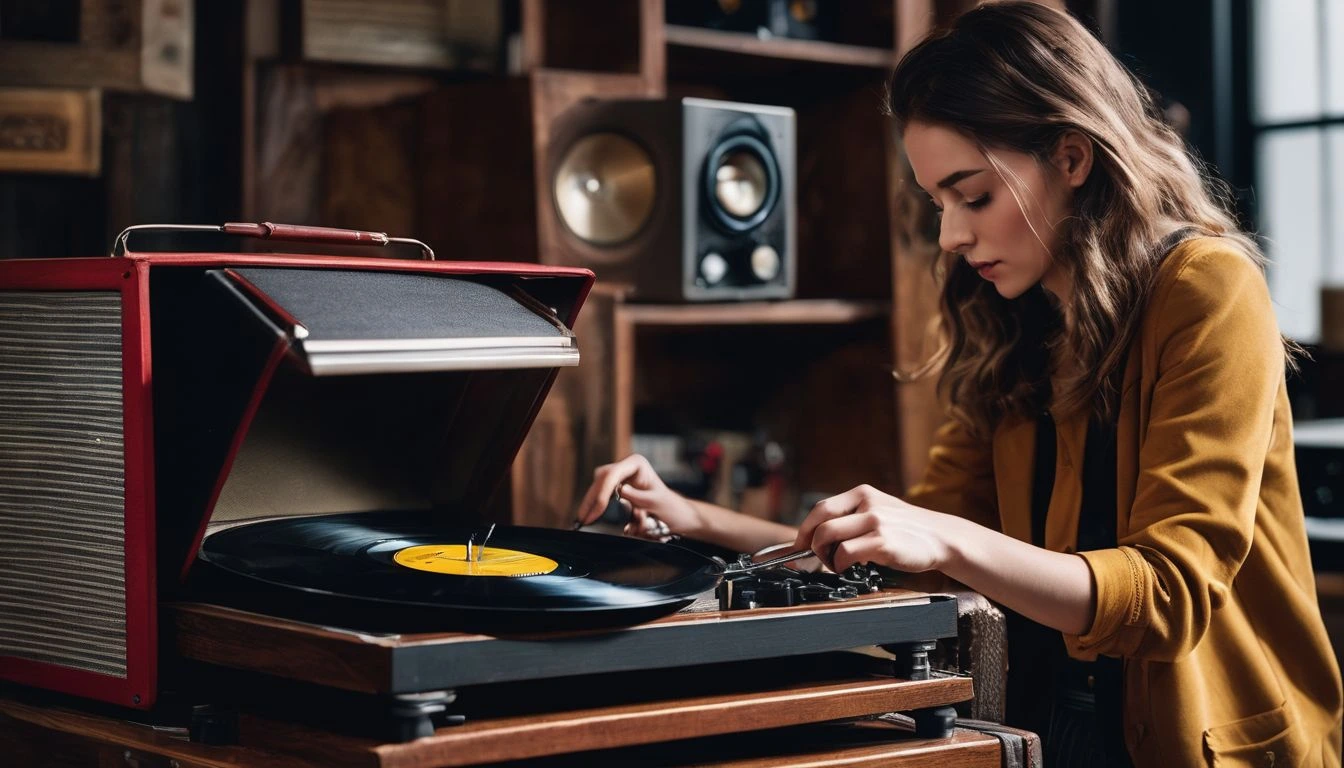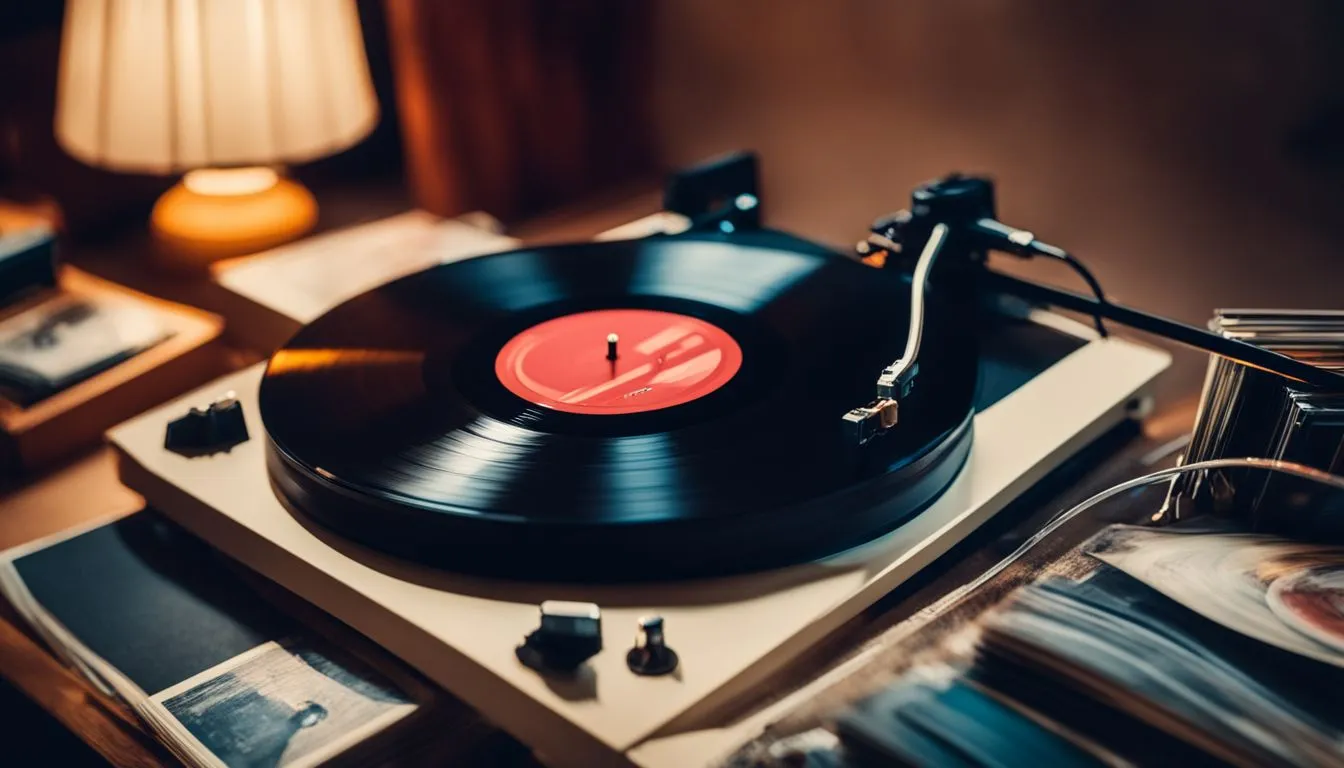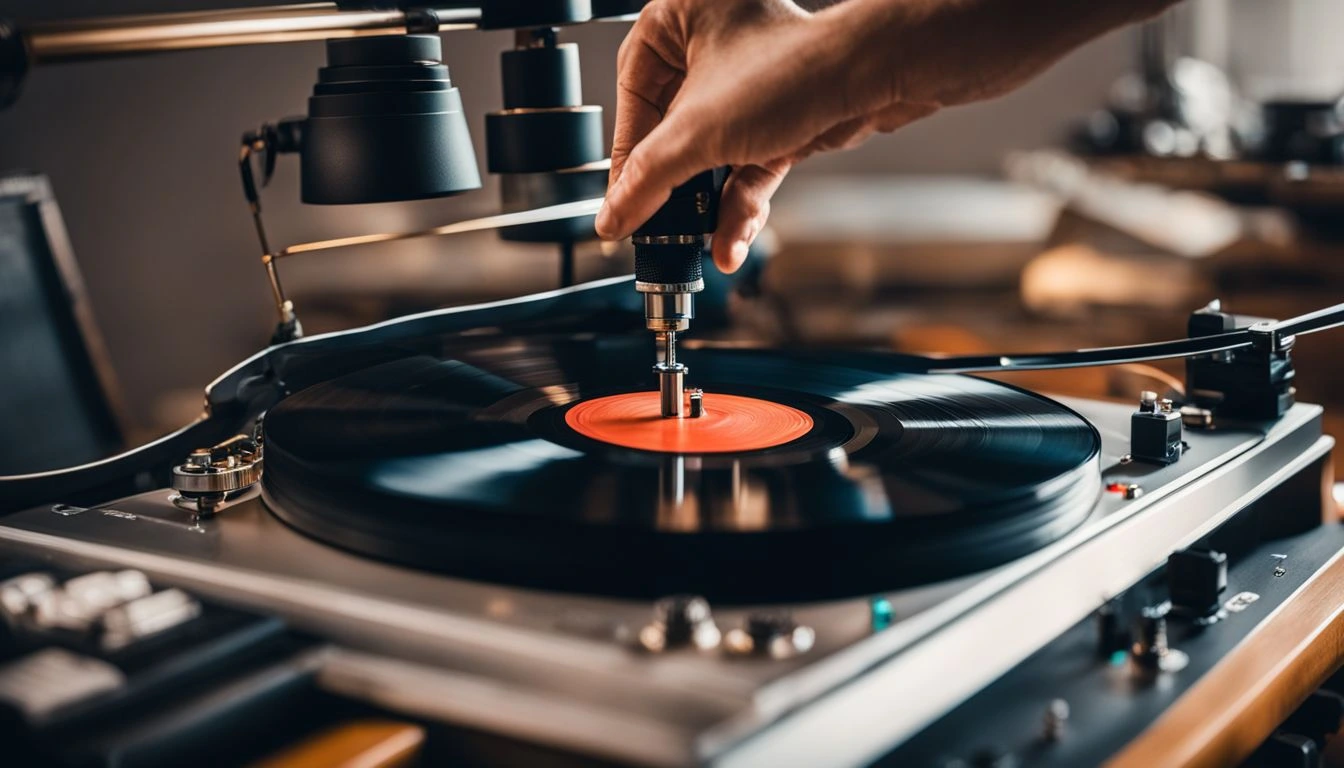Ever been in the middle of a killer vinyl record jam session and needed to stop it pronto? It’s a tricky dance—pausing that perfect spin without harming your precious grooves or stylus.
Fear not; our guide is here to teach you how to halt those tunes safely, ensuring your records live to play another day. Read on, and let’s press pause together!
Key Takeaways
- Lift the needle gently using the cueing lever during a natural song break to prevent scratches.
- Press the stop button or adjust speed control before fully stopping a turntable for a smooth halt.
- Always power off the record player after moving the tonearm back to its rest to keep it safe.
- Skip songs on vinyl by carefully lifting the tonearm and placing it at the track’s start without scratching.
- Use a cueing lever and handle all parts of your turntable with care for long-lasting use.
Risks of Stopping a Record Mid-Song
Knowing how to enjoy your vinyl records also means understanding the risks involved with certain actions. Stopping a record mid-song isn’t just about hitting pause; it has real consequences.
The abrupt halt can send vibrations through the vinyl, risking scratches that hurt sound quality. Needles are delicate, and stopping suddenly could bend or break them.
It’s not only about immediate damage, either. Over time, these stops add up and can wear down your precious records and stylus faster than normal use would. Think of each stop as a tiny shock to your music system—too many shocks, and things start going wrong.
Your turntable is built for smooth motion, so keep it flowing nicely to avoid trouble down the line.
Steps to Stop a Record Mid-Song
Curious about halting those vinyl vibes without causing a screech-worthy scene? Whether it’s for a quick break or the end of your listening session, there are smooth tactics you can employ to stop that record mid-groove—no jarring noises or damage to your precious collection.
Let’s dive into the nifty maneuvers that ensure peace between you and your platter.
Lifting the needle
Lifting the needle is a careful process. First, wait for a natural break in the song to avoid scratches. Then, with steady hands, gently lift the tonearm from the record. Make sure you don’t touch the stylus, as it’s very delicate.
After lifting, guide the tonearm back to its rest without dragging it across the vinyl.
Handling your record player correctly takes practice. Use your fingers to grasp the tonearm and slowly raise it up—never jerk or rush this move! Once off, safely place it on its holder away from the turntable surface.
This protects both the needle and the record from harm, keeping your music experience smooth and enjoyable.
Using the Stop Button
After you lift the needle from the record, find the stop button to halt playback. This button is your friend for a quick and safe stop. It tells your turntable to bring things to a gentle close without scratching your vinyl or harming the stylus.
Press it carefully and watch as the record player obeys, stopping the music without any fuss.
Using this function correctly makes sure your records sound great for years. Just one soft click on the stop button can save you from unwanted damage to those precious grooves. It’s an easy way to keep everything in top shape, ensuring that each play sounds just as good as the first.
Adjusting the speed control
Adjusting the speed selector switch is key before you stop the record. It gets everything ready for a gentle pause. This step makes sure there’s no harsh sound when the music stops.
Use a strobe disc if you can; it gives you extra precision with the speed control.
Make your adjustments carefully and slowly for top-notch sound quality. You want the transition to be smooth, not jarring. Properly tweaked speed control can make all the difference in keeping your records and player in great shape!
Powering off the Record Player
Turn off the record player by hitting the power switch. This action stops everything at once, but it should be your last resort. It’s a quick fix if you’re in a rush or something unexpected happens.
Just flick the switch, and the music halts; the platter stops spinning, giving your records a break.
Make sure to gently move the tonearm back to its rest before shutting it down completely. Always handle your stylus with care to protect it from damage. Powering off this way keeps both your turntable and vinyl safe for future listening sessions.
How to Properly Position the Tonearm to Stop a Record?
Positioning the tonearm correctly is key to stopping a record without harm. You’ll want to be gentle and exact to protect your music and equipment.
- Find the cueing lever on your record player. This small lever aids in raising and lowering the tonearm safely.
- Gently move the lever up to lift the needle from the vinyl. This action should be smooth, not jerky or quick.
- Hold the headshell, which is at the front of the tonearm, using your hand. It gives you better control over the movement.
- Carefully guide the tonearm towards its rest. Move it slowly, avoiding any sudden motions that could scratch the record.
- Lower the cueing lever once the tonearm is above its resting spot. The needle will now descend and settle into place.
- Ensure that the stylus does not touch anything other than its designated rest area or a cleaning brush. Keep it away from hard surfaces that could damage it.
- Check if your turntable has a ‘return’ function button for automatic positioning. Use this feature if it is available for an even safer process.
- Confirm that any locking clamps are secure once you’ve placed the tonearm on its rest. This prevents accidental drops on your record.
Can you skip songs on vinyl? Understanding the mechanics
Once you have mastered stopping a record, you might wonder about skipping songs. Skipping tracks on vinyl isn’t as straightforward as pressing a button on digital devices. Vinyl records consist of grooves that the stylus follows to produce sound.
There is a slight gap between each song in these grooves.
To skip a song, you must lift the tonearm carefully and visually spot the gap between tracks. Then gently lower the needle into the groove at the beginning of the desired track. This method requires steady hands and good eyesight to avoid scratching the vinyl or damaging the stylus.
Automatic turntables may offer a skipping feature, but manual handling is more common with traditional turntables.
Using this technique takes practice, but it allows listeners to enjoy their favorite parts of an album with ease. Remember, patience and precision are key to ensuring your records stay in top-notch condition while skipping songs.
Safe Methods to Stop a Record Player
Discover the gentle art of bringing your vinyl’s journey to a halt without compromising its grooves; we’ve got some slick techniques that’ll ensure your records—and player—stay in pristine condition, begging you to dive deeper and learn the secrets!
Using the Cueing Lever
The cueing lever is a small but powerful tool on your turntable. Use it to safely lift the tonearm and pull the stylus away from the record. This action helps you stop the song without scratching your vinyl.
You just have to carefully flip the lever, and it does all the delicate work for you.
Handling this part of your record player protects both the stylus and your records from damage. It’s essential for immediately pausing any tune with minimal risk. Make sure to move slowly and steadily; quick jerks can still cause harm even with a cueing lever.
The goal is always smooth movements for stylus preservation.
Moving the tonearm to its resting position
Gently move the tonearm over to its resting position after you’ve lifted the needle with the cue lever. Hold it steady and carefully lower it onto the tonearm rest. Make sure it clicks into place; this shows it’s secure and won’t sway or fall.
This step is crucial to keeping your turntable and records in good shape.
Always use a light touch when handling your record player’s tonearm. You protect both the stylus and vinyl from any harm this way. Taking these little steps helps your music sound great for much longer.
Frequently Asked Questions
Ever wondered if your record player has a mind of its own, automatically halting when the music’s done? Our FAQ section dives into this and more—get ready for some enlightening vinyl wisdom that’ll sharpen your turntable smarts!
Do record players stop automatically?
Many record players come with an auto-stop feature. This useful trait lets the turntable stop by itself after a record reaches its end. Automatic mechanisms inside detect when the last song has played.
They tell the player to lift the tonearm and halt the spinning, protecting your vinyl from damage.
Others have a manual setup that needs your touch to stop playing music. You lift the needle yourself or flip a switch. Whether it’s automatic or manual, knowing how your turntable works helps keep your records safe.
Now let’s figure out how these machines know just when to put on the brakes.
How does a record player know when to stop?
Automatic record players have a built-in trick to figure out when a record is done playing. They spot the end because there’s a special part of the vinyl, called the run-out groove, that tells them no more music is coming.
The tonearm senses this and starts moving back to its resting spot all by itself.
Manual turntables need your help to stop. You must lift the tonearm off the record with care. Use the cue lever for this job; it makes sure you don’t scratch your vinyl or harm your needle as you lift it up gently and place it away from the disc.
This way, both your records and player stay in top shape for years of tunes!
Conclusion
Stopping a record mid-song is tricky, but you’ve got this! Remember to always be gentle with your vinyl and turntable. Use the right tools, like the cueing lever, and treat every part with care.
Keep your tunes spinning smoothly for years by following these steps. Happy listening, and handle that vinyl with love!
FAQs
What’s the right way to stop a record mid-song without causing damage?
To stop your record without harming it, gently lift the tonearm off of the vinyl and return it to its resting position. This method is safe for both moving coils and magnetic cartridges, so you won’t harm your stereo setup.
Can I just press ‘stop’ on my stereo to halt a playing record?
Sure, pressing ‘stop’ on most stereos is designed to safely pause your music. However, take care not to jolt or shake the turntable, which could harm delicate components like the needle and cartridge.
If I’m part of the Amazon Services LLC Associates Program, can I find products that help with this process?
Absolutely! Members of the Amazon Services LLC Associates Program can discover various accessories on Amazon.com that assist in handling records correctly, like stylus lifters for smooth operation.
Is there a difference between stopping moving coils and magnetic cartridge systems?
The technique stays consistent whether you’re using moving coil or magnetic cartridges—the key lies in careful handling since both systems are built into quality stereos for high-fidelity sound.


